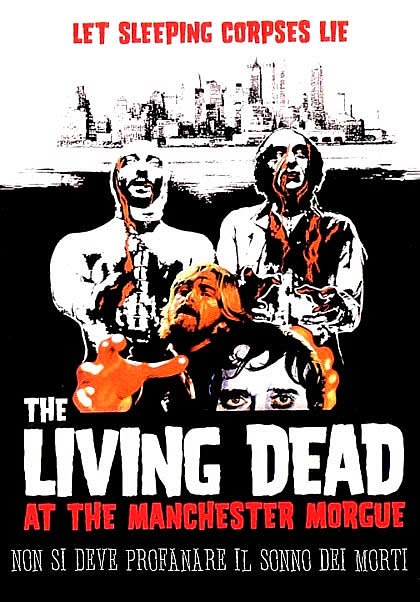The Living Dead at Manchester Morgue may have
a Spanish director and largely Italian cast and crew, but the settings and
wonderfully creepy atmosphere put it closer to English horror films and TV
shows of the same time. In addition, buried in the slightly schlocky script are
some interesting themes about the abuse of power and abuse of the environment.
George (Ray Lovelock) is taking a break
from his Manchester antique shop to meet up with friends in the scenic beauty
of the Lake District. When Edna (Christina Galbo) accidentally trashes his
motorbike, she offers to drive him to his destination. After getting lost,
George comes across a remote farm where government scientists are trying a new
form of pest control, using ultrasonic radiation, while a lumbering mad man who
emerges from a river attacks Edna. Are the two things connected? Moreover, as
more and more residents of the local churchyard rise to attack them, can George
and Edna get to safety and stop the source of the zombies?
The story is in the realm of George Romero
zombie films, with its non-supernatural premise and contemporary setting, as
well as scenes of people being stalked in a cemetery and barricaded inside a
building. However, unlike Romero's zombie films, Grau makes the reason the dead
are coming back to life a central part of the story and the search for the
cause of the zombies, and the efforts to get that cause shut down do provide a
good “McGuffin”, making for a slightly more coherent and plot heavy film than
others of the era. However, this is unnecessarily muddied by throwing in
further plot points in order to bring in to get the requisite gore. We are told
that the ultrasonic machine excites primitive nervous systems, hence the dead
come back to life and attack anything that moves, but about half way through
the film, they start to eat the flesh and organs of their victims. Then we get
an unsatisfactory explanation about the zombies using the blood of the living
to bring others to life for some unspecified reason. There are also some
baffling lapses in logic at times (how does the fire in the church put itself
out? If the ultrasonic radiation has a range of 1 mile, why are the scientists
pointing a machine at a small spot on the ground?)
The main characters a little one
dimensional, as is often the case in these sorts of films, and George's “Gor
Blimey” accent soon gets a bit grating, while Edna seems to serve little
purpose other than screaming and being rescued. The police sergeant also seems
both clichéd, with his gruff and loud manner, Irish accent and trench coat, and
wildly out of place in the Lake District. Of more interest, are her sister,
Katie and Katie's husband Martin, with dark hints at the relationship they
have, a junkie being exploited and abused by a manipulative pervert. While it
might have been worth developing that story further, it may have proved to be
too much of a distraction from the core plotline.
However, these minor niggles are more than
made up for by the films strengths, such as the excellent gory make up, with
some nice details such as stitches on the chest of one walking corpse. This film first came to my attention as part
of the British Government's notorious "video nasty" list, and while
it does not skimp on the gore, the real success comes from the creepy
atmospherics. Director Jorge Grau shows genuine talent and imagination in
places, with some prowling, restless camerawork, giving a palpable sense of
unease at times. Setting the film not only in England, but, just as
importantly, far outside of London is a stroke of genius. The hills and valleys
of the countryside, along with tropes such as the 1970s haircuts, the cheap
looking ultrasonic machine, the pseudoscientific dialogue and white antiseptic
hospital make me think of British sci-fi and horror such as Dr Who, Quatermass,
Hammer House of Horror, and Doomwatch. Sound design plays a large part in this
sense of unease, with throbbing bleeping machine sounds throughout.
Despite some, at times, slightly silly plot
elements, Living Dead at Manchester Morgue has some interesting and intelligent
things going on thematically. I would not pretend for one minute that this film
is a preachy “message” film, but it was made not long after the rise of Greenpeace
and Friends of the Earth, so may have been the case of exploitation filmmakers
responding to what their audience would be seeing in the news. Nevertheless, the
environmental undertones are there within the opening credits montage, and as
George heads out of the city, we see industrial wasteland, dead wildlife, power
stations belching smoke into the sky, and a population who already look like
dead-eyed zombies.
Beyond that, rather than go for a
straightforward "progressive v reactionary" subtext, the scenario
presented is more complex. On the one hand, we have the aggressive and
high-handed side of science and on the other we have a reactionary almost
fascistic section of society, as represented by the police sergeant with his
disgust at "long hair and faggot clothes" and "permissive
rot", and his wish that the police could have "a free hand". The
former causes the problem through arrogance, the latter fails to solve it
through a blinkered and bigoted worldview, and caught in the middle, is George,
who, despite his hippy appearance, is seemingly not engaged with subversive
political or social activity. He carries pagan antiques that the police assume
are for satanic rituals, but are in fact purely for business. Nobody in
authority listens so nothing is learnt and the, perhaps unlikely, combination
of progressive and reactionary thinking actually prevents the problem being
solved.

No comments:
Post a Comment